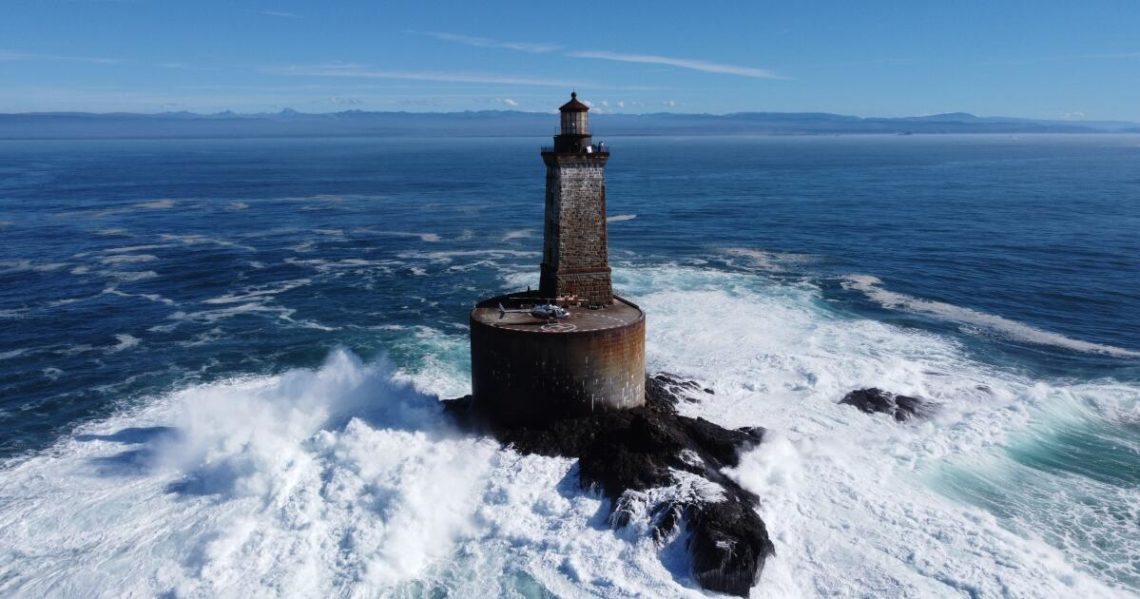CRESCENT CITY, Calif. — John Gibbons shivered in the back of the little boat hauling him to his first assignment as a member of the U.S. Coast Guard.
It was 1953. Gibbons was a baby-faced 18-year-old kid from Ohio who had only recently seen the ocean for the first time. And he had fresh orders to get to work at one of the country’s most isolated — and most dangerous — lighthouses.
The St. George Reef Lighthouse, six miles off the coast of California’s sparsely populated northwest corner, stands atop a sheer rock surrounded by nothing but the cold, tempestuous Pacific.
“We came out of the fog, and I saw that light — it looked like something out of a horror movie,” said Gibbons, now 91, adding: “I thought, ‘Holy cow, how’d they ever build anything like this out in the middle of the ocean?’”
The St. George Reef Lighthouse is listed on the National Register of Historic Places as an architectural masterpiece and an important symbol of California maritime history. Constructed over a decade in the late 1800s, it is the most expensive American lighthouse ever built.
But time and briny air have taken their toll. The lighthouse has been mostly abandoned for 50 years. Its lantern room leaked. Its handrails rusted. Its paint peeled, and its original wooden floors turned spongy. The hook and boom that once hoisted boats out of the water and onto the rock fell apart long ago.
Few people have ever set foot inside. But a small group of volunteers and old salts are on a mission to fully restore the place and draw lighthouse-loving tourists to this struggling corner of California, where industries devoted to logging and fishing cratered long ago.
The challenges are monumental. Climate change is sure to batter this stone sentinel with higher seas and stronger storms. More immediately, the lighthouse is now accessible only by an expensive helicopter ride, if the winds are merciful and it is not shrouded by fog.
“If you look at the project in its entirety, you want to fold your tent and forget it,” said John Zimmerman, president of the St. George Reef Lighthouse Preservation Society. “But the fact of the matter is — and I remind the volunteers of this — the people that had the hard job are the ones that built the thing in the first place.”
Zimmerman’s group doesn’t have a lot of money. And maybe they’re a little romantic. But history, he said, is worth fighting for.
“Every time I go out there, it’s a religious experience for me,” he said. “I know that sounds corny. But standing out there, 25-mile visibility, beautiful lighthouse, beautiful scenery — it’s as close to God as you can get, in my mind.”
All lighthouses, he said, have a great story. And this one, he adds, “has a better story than most.”
As hordes of ships sailed to California during the Gold Rush, the West Coast’s first lighthouse was illuminated on Alcatraz Island in 1854. Since then, more than 40 lighthouses have graced the state’s rugged, foggy shores.
The northernmost is on St. George Reef, a chain of volcanic formations nicknamed the Dragon Rocks by a British explorer in the 1700s because of the danger they posed to ships.
On July 30, 1865, just three months after the Civil War ended, disaster struck.
A side-wheel steamer ship called the S.S. Brother Jonathan got caught in a windstorm and struck one of the rocks. The overloaded vessel — carrying heavy railroad and mining equipment and a huge shipment of gold — sank within 45 minutes, killing all but 19 of its 244 passengers and crew.
Afterward, the U.S. Lighthouse Board pleaded with Congress to build a lighthouse on the reef. But the war-torn country was broke. It took 17 years for the government to approve funding and, because money kept running out, another decade for construction.
The lighthouse cost $752,000, or about $27 million today. It cost more than the Statue of Liberty, completed six years earlier.
Workers lived aboard a schooner moored to North West Seal Rock, which they accessed via aerial tramway, riding on a small platform connected to a cable stretched between the ship’s masts and the rock, like a zipline.
They blasted off the top of the rock with explosives and sculpted it into a terrace that would anchor the lighthouse‘s foundation — known as a caisson. They used cargo nets and boom derricks to hoist the six-ton granite rocks that would compose the 70-foot-high oval caisson and five-story tower.
Giant waves repeatedly swept men off the rock, and one worker fell to his death, according to the National Park Service.
On Oct. 20, 1892, the Fresnel lens was illuminated for the first time, casting a beam that could be seen for more than 20 miles. That day, the San Francisco Chronicle declared the lighthouse was “so strongly built that the tremendous waves which often strike it might as well be the ripples of a brook.”
Life at the St. George Reef Lighthouse — a so-called stag station where no women or children were allowed — was brutal and lonely.
Within its first year of operation, an assistant keeper who left the rock in a small boat bound for Crescent City vanished into the sea. Of the 80 men who served there between 1891 and 1930 — before the Coast Guard took over operations — 36 resigned and 27 transferred to other light stations, according to the 2007 book “Sentinel of the Seas: Life and Death at the Most Dangerous Lighthouse Ever Built.”
In 1951, three Coast Guardsmen drowned after a rope lowering their boat from the rock snapped, plunging them into the icy water.
The next year, Floyd Shelton, a 19-year-old Guardsman from Portland, got orders to replace one of the dead men.
Shelton, now 93, told The Times that “the accommodations were grim.” The Guardsmen “hot-sacked” their twin bunks, with the man coming off duty hopping into the still-warm bed of the man starting his shift. They rarely showered because there was little fresh water.
But the place was undeniably beautiful, said Shelton, who recalled climbing onto a steel cross-section boom and lying on it to watch whales migrating beneath him. Once, he was sprayed by a whale spout.
“I’ve been accused of being a romantic,” Shelton said. “There’s not many of us left that did lighthouses or lifeboat stations, guys — mostly guys, almost exclusively — like me.”
The men were supposed to rotate: 10 days on the rock, 10 days at the on-shore station. But in the fall of 1952, a storm stranded Shelton and a few other Guardsmen for more than 45 days.
Waves crashed over the lens room 146 feet above the sea, and water cascaded down the circular stairs “like a waterfall,” Shelton said.
The men ran out of food, subsisting on what they scrounged up: vitamins pills and pancake mix. When a big wave hit, the whole lighthouse shook.
“All we did was hope the thing held together,” he said. “And it did.”
The lighthouse required a tremendous amount of work to maintain, said Shelton, who nearly fell off the tower while painting the oil room beneath the lens and was wind-whipped while greasing the cables for the boom. Now that it’s been empty for so long, Shelton is skeptical the lighthouse can be restored, despite the devotion of volunteers.
“It’s just a monumental task … but more power to them,” he said.
The Coast Guard decommissioned the St. George Reef Lighthouse in 1975, replacing the grand edifice with a floating, automated buoy light.
The final entry in the logbook read: “After four score and three years, St. George Reef Light is dark. … May Mother Nature show you mercy. You have been abandoned, but never will you be forgotten.”
In 1986, a group of locals, upon learning the government planned to sell the rapidly decaying beacon as scrap, started the St. George Reef Lighthouse Preservation Society. The federal government eventually deeded the lighthouse to Del Norte County, which now leases it to the nonprofit for $1 a month.
When Huell Howser visited the lighthouse in 1995 for an episode of his TV show “California’s Gold,” he was joined by the late Guy Towers, the preservation society’s founder, who had fought to save the beacon for a decade but had not yet been able to reach it. The men were lowered, one at a time, in wire baskets from a hovering Coast Guard helicopter.
“Touchdown: A little hard! But believe me, I was glad to be on that big ol’ rock,” Howser said.
For years, members of the tiny preservation society — their ages now ranging from 60s to 80s — have flown out in helicopters, landing on the caisson.
They bring generators and stay overnight, removing peeling paint and plaster, hauling out trash and rotted furniture. They have power-washed bird poop, rebuilt rusted railings — and, in one epic feat, replaced the lantern room, suspending the original dome from a helicopter and flying it to shore.
They installed a solar-powered lens, illuminating the lighthouse for the first time in decades. But the wind carried away the solar panels earlier this year.
For years the volunteers had to limit their work to a few winter months annually because of federal wildlife officials who wanted to protect the mating season of sea lions on the rock. That deed restriction has since been lifted.
“We’ve been fighting like hell for 30 years,” said Jim McLaughlin, a deep-sea fisherman and an original member of the preservation society. “Because it’s so expensive to get people out there, you don’t waste time. You’ve got to have a trade: Electrician. Pipe fitter.”
Growing up, McLaughlin, 84, could see the lighthouse beam from his bedroom window. And, he said with a laugh, “we’d shoot ducks at night by it.”
For years, the preservation society’s repairs were funded, in part, by small donations and occasional public helicopter tours. But flights cost thousands of dollars each.
“The big challenge is raising money to hire a helicopter, and then, of course, trying to find a helicopter near enough that has the required flotation devices and has a sling hook that can haul baskets of supplies out there,” said Zimmerman, who hasn’t been to the lighthouse since summer 2024.
Zimmerman, a 68-year-old retired landscaper — “with the arthritis to prove it” — took the helm of the nonprofit a few years ago and spends much of his time fundraising, applying for historic preservation grants and trying to persuade people to care about a lighthouse they can barely see from shore.
He envisions a fully restored, publicly accessible lighthouse being used as “nature’s classroom,” by people who stay for days at a time to study marine mammals, birds, weather patterns, and tides.
Zimmerman said engineers have assessed the lighthouse and estimated that a full restoration, including helicopter transportation, would cost around $10 million — big money in a rural county of 27,000 people.
Tyler Finkle, a structural engineer who has restored offshore lighthouses across the country, said that while restoration seems “like a herculean task,” it is doable. Much of the corroding metal throughout the structure needs to be replaced, but “the masonry’s in good condition,” he said.
Finkle, the division manager of historic preservation for ICC Commonwealth, the company that assessed the lighthouse, is working on the ongoing $16-million restoration of Pigeon Point Lighthouse south of San Francisco owned by California State Parks.
The St. George tower, he said, is in better shape.
Among those who want to see the St. George Reef Lighthouse shine again is Gibbons, who served 39 months on the rock, a Coast Guard record.
Both he and Shelton, upon arriving in Crescent City for the first time, mistakenly thought they would be serving at Battery Point Lighthouse — a cheery, red-roofed, Cape Cod-style house on a tiny island so close to shore that you can walk to it at low tide. Gibbons said his heart sank when someone handed him a pair of binoculars, pointed to the sea, and said St. George was out there.
Life there was hard, but it was an adventure, Gibbons said. He hooked lingcod and other fish from the rocks. He set up a TV with one channel (they watched a lot of “The Liberace Show”). And he ate steak most nights.
In the winter of 1955, a storm stranded him and four other men for about 30 days. On Christmas Eve, a radio station in Crescent City dedicated a show to them, said their names, “and when ‘Silent Night’ came on, there wasn’t a dry eye in the galley,” he said.
For Christmas dinner, they toasted moldy bread, and Gibbons surprised everyone with a single can of Spam that they split among everyone.
About three years ago, he got on a helicopter and saw the lighthouse for the first time in decades. His old Marilyn Monroe calendar, he noted, had been removed from the galley.
He hopes the preservationists succeed, despite the odds.
“There is only one St. George Reef Lighthouse,” he said, “and it would be a shame to just let it go.”
The post A deadly history haunts this imperiled California lighthouse. Here’s why fans want to save it appeared first on Los Angeles Times.




